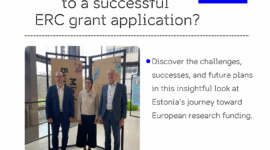In a situation of rapid digitalisation of public and private sector services the methods for digital identity verification and authentication are also becoming increasingly important for citizens. E-residency is a form of digital authentication, which gives remote access to digital services without the need to actually live in the country.
The e-residency research group from TalTech Ragnar Nurkse Deparment of Innovation and Governance led by Professor Anu Masso recently published the article “Transnational Digital Identity as an Instrument for Global Digital Citizenship: The Case of Estonia’s E-Residency”. The article examines the aspects concerning the digital opportunities and digital inequalities related to e-residency by analysing the links between the individual motives to apply for a digital identity and the level of e-government development in the country of origin.
A member of the research group and the first author of the article, a PhD student of the Institute of Social Studies of the University of Tartu, Piia Tammpuu says, “The Estonian e-residency application data of 2014-2017 used in our analysis indicate that although the e-residency programme achieved a global reach already in the first years, the background of applicants in terms of the country of origin is geographically very uneven.”
Estonian e-residency as a government-supported transnational digital identity is argued to provide an advantage particularly to citizens from countries with lower levels of e-government development. Therefore, the aim was to analyse whether and how does the e-residency programme compensate the lack of digital opportunities particularly for citizens from countries with relatively lower level of e-government development. The analysis, however, showed that the majority of the applicants come from digitally advanced countries: 90% of the applicants are citizens of the countries with a high or very high level of e-government development, measured by the E-Government Development Index (EGDI) of the United Nations. Only one tenth of applicants are from countries with an average or low level of government development. Thus, the e-residency programme will potentially benefit mostly those citizens who are already more privileged in a global context in terms of the digital opportunities offered by their country of origin. In other words, despite a global reach of the e-residency programme, the programme tends to be more available to those who are already “digitally more empowered” and therefore reflects the existing digital divides between countries and regions.
According to the authors, the main contribution of the study was to explain, by using the multilevel analysis method, the applicants’ motives, taking into account their socio-demographic background (e.g. citizenship) as well as the differences in the digital and economic development in their countries of origin. The findings suggest that individual motives to apply for e-residency vary depending on both the EU citizenship of applicants and the level of e-government development in the country of origin. Citizens of digitally more advanced countries are more likely to apply for e-residency because of their general interest and define themselves as “fans of e-residency”. Citizens from digitally less developed countries, however, applied for e-residency in particular out of practical interest to use certain e-services and digital solutions. Thus the findings imply that e-residency still tends to provide a certain “compensation effect“ for them.
“In conclusion, the study draws attention to the aspects of the digital divide related to the Estonian e-residency programme and raises a question whether initiatives similar to e-residency reduce or rather contribute to the reproduction of transnational digital inequalities in the long run,” Anu Masso says. According to Masso, it can be assumed, based on the study carried out, that the abovementioned inequalities may occur in certain usages of the e-resident’s ID card: accessibility to various services, awareness of the potential data created in the course of e-residency, opinions on potential risks and opportunities. However, these topics require a further quantitative and qualitative analysis for further explaining the mechanisms of the digital inequalities.
Currently the research group led by Professor Masso is carrying out further in-depth interviews among e-residents to find out their understanding of the rights and obligations as global digital citizens and the opportunities and risks related to their digital footprints.
Source: Information Systems Frontiers “Transnational Digital Identity as an Instrument for Global Digital Citizenship: The Case of Estonia’s E-Residency” https://doi.org/10.1007/s10796-019-09908-y
Additional information: Professor at TalTech Ragnar Nurkse Department of Innovation and Governance Anu Masso, anu.masso@taltech.ee
Original post compiled by Kersti Vähi, TalTech Research Administration Office
Photo by Rasmus Jurkatam
 Back
Back



